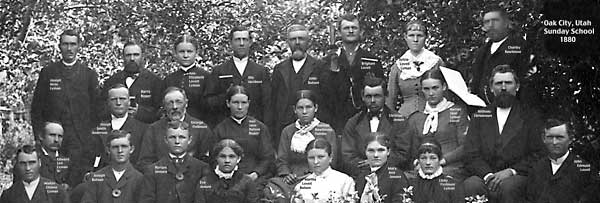 |
||
|
The first home in Utah for William Morgan's parents, the Thomas and Ann Morgan family, was in the town of Kaysville, Utah located about 20 miles north of Salt Lake City on a somewhat narrow strip of good farming land between the Great Salt Lake and the Wasatch Mountains. William's older brother Edward and uncle Joseph had already settled in Kaysville two years before Thomas and Ann's family arrived from England. Kaysville was a frontier Mormon settlement founded in 1850. After more than a year there, Thomas and Ann had their first Utah-born child: William Thomas Morgan, born in Kaysville, Utah 26 December 1856. William Morgan's father, Thomas Morgan, is identified as a founder of both the communities of Santaquin and Goshen, Utah, which are only about seven miles apart, located in southern Utah County just south of Utah Lake and about 30 miles south of Provo. He first appears in a list of settlers arriving in 1856 in what is now Santaquin to help build a fort and settlement there, then called Summit. So William's father was in the process of pioneering new communities when william was born in 1856. In 1857, William's father Thomas was listed among the first pioneers of the town of Goshen, about seven miles to the west of Santaquin. William's father was clearly on the move during William's early years, assisting with the pioneering one new community after another. In 1866, when William was 10 years old, the Morgan family made another move, this time to the newly founded settlement of Deseret in Millard County, central Utah. Deseret is located less than 10 miles from the present-day town of Delta, now a fertile farming area on a flat plain traversed by the Sevier River. By 1867 Thomas Morgan and his friend John Whitlock Radford were among a few who began grazing cattle during the summer in the Oak Creek Canyon area located about 20 miles northeast of Deseret. In 1868, after the main dam at Deseret broke for the fourth time, settlers there began looking for a new place to live. In fact, by the end of 1870 Deseret had been completely abandoned and left as a ghost town. (It was re-formed again as a new town in 1875.) Our Morgan families were among the first Deseret settlers to look for new opportunities on higher bench lands east of the Sevier River plain and closer to mountain canyons and grazing lands. By 1868 the Morgan and Radford men had set up camp in the Oak Creek area to ranch on a more permanent basis. Together they, with two other men, fenced in 10 acres north of the future townsite where they planted a wheat crop. In a relatively short time Oak Creek (later called Oak City) became a typical nucleated Mormon town of farmers who lived on town lots rather than on farmland out away from town. Each town lot was a farm home. Barns, granaries, chicken coops, and other farm buildings were built on town lots behind the owner's houses, while farmlands away from town remained clear of buildings. By the time he was 12 years old William Morgan had lived with his family in several newly pioneered Utah communities and was living in Oak City where his father had a lot in town along with farming and grazing lands nearby. William's life at this time would have been in the fields farming or on the rangelands herding cattle. In the spring of 1872 original Oak City resident Thomas Morgan surveyed a dam and ditch site on the Sevier River about 12 miles north of Oak City. He homesteaded farm land on the banks of the Sevier River and brought the "Morgan Ditch" to this land to irrigate it. He first built a dugout there on a hill above the farmland, then built a log house on top of the dugout. Later he built an adobe house across the ditch from from the cabin. This area developed into the small community of Leamington, Utah. This is where William Morgan was living in 1880 when he married Sarah Lovina Ross.
This picture of an Oak City, Utah LDS sunday school class was taken in 1880, the same year William Morgan married Lovina Ross about 10 miles away in Leamington, Utah. William's father was one of the founding members of the town of Oak City and he and his family (including William, who was 12 years old when the family moved to Oak City and 16 years old when they moved to Leamington) lived in Oak City until they moved to Leamington about 1872. The Morgan family was active in the church, maintained close ties with Oak City, and probably knew most of the people in this picture. George Finlinson, second from left in the center row, bought Thomas Morgan's farm before Thomas moved to Wyoming in 1888. |
|||
|
For many years, as we worked on the morganclan.com website and production of the Thomas Morgan family history book (published in 2005) I wanted to write a life history for my grandfather William Thomas Morgan. There are a number of reasons. First, I knew him when I was very young (he died when I was 10 years old) because my dad (Kenneth Morgan) took me with him to Rexburg to get loads of wood slabs which we delivered to William when he was living in a small trailer in his daughter Orlean's front yard. Second, because my father had many characteristics in common with William, I have many characteristics in common with both of them, and feel I know William better than anyone else still living. I am nearly 70 years old. I won't be around forever. If I don't write this it won't get written. And third, because I have collected, scanned, archived, and published on the morganclan.com website all the pictures of the William and Lovina Morgan family that I could find in six years of searching. I have literally spent years working with visual images of William and his family and thnking about William and his life. Much of William Morgan's early life history can be gleaned from the history of his father and mother, Thomas and Ann Morgan, presented on this website. Here we will present the history of William and Lovina after they married. There were two major factors that shaped the early life of William Morgan. The first was his own obedient nature. The second was the compulsive pioneering of his father. William Morgan was an obedient son. Neither rebellious nor angry, he is most accurately described as 'orthodox' in the sense that he believed in following the rules and lived the way his parents wanted him to live. In his youth and throughout his life he was dedicated to the LDS church. It was his nature to want to please people. He was shy around people and easily taken advantage of by those who were willing to expliot his mild nature. William's father, Thomas Morgan, continually pushed on to new frontiers from the time he arrived in Utah in 1855 until he settled in Idaho in 1891. He was involved in the founding of at least seven communities in Utah, Wyoming and Idaho. Thomas didn't move from one community to another. He moved to new, raw, frontier land and participated in the founding of a new community where none had existed before. This meant the family lived in dugouts until log buildings could be built and then moved on to repeat the process in a new place. Living quarters were primitive and crowded. Farm work (clearing land of trees and brush and digging ditches to get water on the land) was brutal. And the process of building places to live must have seemed never ending. William Morgan was an English/American hybrid. His parents were farm laborers in England who had five children in England (one of whom lived less than three months) and were about 34 years old before they left England in 1855. They brought the four surviving children to America and William was the first child born in America. So William was raised on the frontier in Utah by parents who were English by birth and with siblings who had been born in England. The Thomas and Ann Morgan family was a deeply religious family, the parents having converted to Mormonism in England during a period of religious fervor that saw large numbers of people convert to the Mormon church. This was more than just a conversion. The church was bringing the converts to America so they could be sent to Utah to build a new Zion. So conversion also meant saying goodby to England and their families there. For these converts, their faith in the church was the source of their sustaining strength for the dangerous journey to America and the unknown frontier. Once in America the church remained important in their lives but a new vista opened to them. These landless laborers from England could now obtain title to land through the homestead act and own their own land. On being a good person. This aspect of William Morgan's personality is a little difficult to describe. He was a good person, but more than that, he was a person who wanted to be a good person. Not wanted to look good or make others think he was good. He just wanted to be good. It came naturally to him. He wanted to do the right thing. He believed in his religion, even at a young age when boys are often rebellious or distracted, and he followed the teachings of his religion all his life. He was a remarkable man in this respect.
The story did not end well for either Lovina or her daughter Jane. Jane went on to marry a man who fled the law after being
caught having sex with his own daughter, leaving Jane destitute. Lovina, after a life of brutal hard work, died of strychnine
poisoning, a horrible death.
I have personally put more research, time, thought and meditation into the marriage and life of William Morgan and Lovina
Ross than into any other family on our rather large Morganclan website. I have struggled to understand them both. There is
an account by Al Morgan about how Lovina loved to have the young men working on the farm come in for meals. There are questions
about why she got the strychnine poison and it wasn't until after her death that William got sick from it. Questions that
make me uneasy. I have asked Heavenly Father to show me all the details of their lives. But He has not. So I have to conclude
that the mysteries of the human heart are deep and unfathomable. And that Heavenly Father sees nothing to be gained from revealing
all. |
|||
